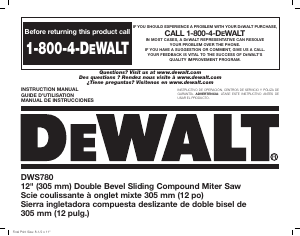
10
45° BEVEL OVERRIDE (FIG. 7)
There are two 45° bevel override levers (AC), one on each side of the saw. To bevel the saw,
left or right, past 45°, push the 45° bevel override lever (AC) rearward. When in the rearward
position, the saw can bevel past these stops. When the 45° stops are needed, pull the 45°
bevel override lever forward.
CROWN BEVEL PAWLS (FIG. 8)
When cutting crown molding laying flat, your saw is equipped to accurately and rapidly set a
crown stop, left or right (refer to Instructions for Cutting Crown Molding Laying Flat and
Using the Compound Features under Cutting Crown Molding). The 33.9° crown bevel
pawl (AD) can be rotated to contact the crown adjustment screw (AF). The saw is factory set
to be used for typical crown in North America (52/38), but can be reversed to cut non-typical
(45/45) crown. To reverse the 33.9° crown bevel pawl, remove the retaining screw (AG), the
22.5° bevel pawl (AE) and the 33.9° crown bevel pawl (AD). Flip the 33.9° crown bevel pawl
so the 30° text is facing up. Reattach the screw to secure the 22.5° bevel pawl and the crown
bevel pawl. The accuracy setting will not be affected.
FIG. 8
AE
AD
AH
AF
AB
AG
AI
AJ
O
P
22.5° BEVEL PAWLS (FIG. 8)
Your saw is equipped to rapidly and accurately set a 22.5° bevel, left or right. The 22.5° bevel
pawl (AE) can be rotated to contact the crown adjustment screw (AF).
RAIL LOCK KNOB (FIG. 4)
The rail lock knob (V) allows you to lock the saw head firmly to keep it from sliding on the rails.
This is necessary when making certain cuts or when transporting the saw.
DEPTH STOP (FIG. 9)
AK
FIG. 9
AL
AM
The depth stop allows the depth of cut of the blade to be
limited. The stop is useful for applications such as grooving
and tall vertical cuts. Rotate the depth stop (AK) forward and
adjust the depth adjustment screw (AL) to set the desired
depth of cut. To secure the adjustment, tighten the wing
nut (AM). Rotating the depth stop to the rear of the saw
will bypass the depth stop feature. If the depth adjustment
screw is too tight to loosen by hand, the provided blade
wrench can be used to loosen the screw.
SLIDE LOCK LEVER (FIG. 10)
The slide lock lever (AN) places the saw in a position to maximize
FIG. 10
AN
cutting of base molding when cut vertically as shown in
Figure25.
AUTOMATIC ELECTRIC BLADE BRAKE
Your saw is equipped with an automatic electric blade brake
which stops the saw blade within 5 seconds of trigger release.
This is not adjustable. On rare occasions the brake may not
engage and the blade will coast to a stop. If this occurs, wait
for several minutes before continuing use. If the condition
persists, there may be a fault condition. Have the tool serviced
by an authorized D
WALT service center.
Always be sure the blade has stopped before raising the arm and removing the blade from
the kerf plate. The brake is not a substitute for guards. Ensure your own safety by giving the
saw your complete attention.
GUARD ACTUATION AND VISIBILITY
CAUTION: Pinch Hazard. To reduce the risk of injury, keep thumb underneath the handle
when pulling the handle down. The lower guard will move up as the handle is pulled down
which could cause pinching.
The blade guard on your saw has been designed to automatically raise when the arm is
brought down and to lower over the blade when the arm is raised.
The guard can be raised by hand when installing or removing saw blades or for inspection of
the saw. NEVER RAISE THE BLADE GUARD MANUALLY UN LESS THE SAW IS TURNED
OFF.
NOTE: Certain special cuts of large material will require that you manually raise the guard.
Refer to Cutting Large Material under Special Cuts.
The front section of the guard is louvered for visibility while cutting. Although the louvers
dramatically reduce flying debris, they are openings in the guard and safety glasses should be
worn at all times when viewing through the louvers.
ASSEMBLY
Bench Mounting
Mounting holes (E, Fig. 4) are provided in all 4 feet to facilitate bench mounting. (Two different-
sized holes are provided to accommodate different sizes of screws. Use either hole, it is
not necessary to use both.) Always mount your saw firmly to a stable surface to prevent
movement. To enhance the tool’s portability, it can be mounted to a piece of 1/2" (12.7 mm)
or thicker plywood which can then be clamped to your work support or moved to other job
sites and reclamped.
NOTE: If you elect to mount your saw to a piece of plywood, make sure that the mounting
screws don’t protrude from the bottom of the wood. The plywood must sit flush on the work
support. When clamping the saw to any work surface, clamp only on the clamping bosses
where the mounting screw holes are located. Clamping at any other point will interfere with
the proper operation of the saw.
CAUTION: To prevent binding and inaccuracy, be sure the mounting surface is not warped
or otherwise uneven. If the saw rocks on the surface, place a thin piece of material under one
saw foot until the saw sits firmly on the mounting surface.
Changing or Installing a New Saw Blade (Fig. 11)
WARNING: To reduce the risk of serious personal injury, turn tool off and remove
the battery packs or power supply before transporting, making any adjustments,
cleaning, repairing, or removing/installing attachments or accessories. An accidental
start-up can cause injury.












Join the conversation about this product
Here you can share what you think about the DeWalt DHS790AT2 Mitre Saw. If you have a question, first carefully read the manual. Requesting a manual can be done by using our contact form.